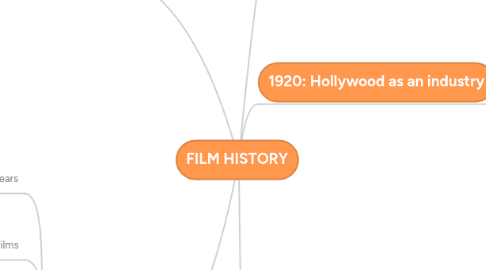
1. 1930
1.1. Talkies
1.2. Film genders
1.2.1. Femme fatale
1.2.1.1. Marlene Dietrich
1.2.1.2. Mae West
1.2.1.2.1. Sarcasm
1.2.1.3. Man version
1.2.1.3.1. Clark Gabel
1.2.2. Film noir
1.2.2.1. The shame of the nation
1.2.2.2. Scarface
1.2.3. Horror
1.2.3.1. Tod Browning
1.2.3.1.1. Dracula
1.2.3.1.2. The mummy
1.2.3.1.3. Freaks
1.2.3.1.4. Frankenstein
1.2.4. Screwball comedy
1.2.5. Expensive/Epic films
1.2.5.1. Tarzan the ape man
1.2.5.2. King Kong
1.2.5.3. The adventures of Robin Hood
2. 1940
2.1. During the war years
2.2. Realistic films
2.2.1. Casablanca
2.2.2. The great dictator
2.2.2.1. Anti-fascist films
2.2.3. B-movie
2.3. Birth of film noir
2.3.1. The maltese falcon
2.4. Foreign influences
2.4.1. Hitchcock
2.4.1.1. Rebecca
2.4.1.2. Shadow of a Doubt
2.4.2. J. Arthur Rank
2.4.2.1. Great expectations
2.4.2.2. Oliver twist
2.4.3. Jean Cocteau
2.4.3.1. La belle et la bete
2.4.4. Italian- Neo-realism
2.4.4.1. Open city
2.4.4.2. The bicycle thief
3. Silent Period
3.1. Lumiere Brothers
3.1.1. Cinematographe
3.1.2. Workers leaving the factory
3.1.3. Arrival of a train
3.2. George Melies
3.2.1. A trip to the moon
3.3. Edwin Porter
3.3.1. The great train robbery
3.4. Griffith
3.4.1. The birth of the nation
3.5. Charlie Chaplin
3.5.1. The new janitor
3.5.2. The tramp
3.6. Buster Keaton
3.6.1. Stoneface
3.7. Carl Dreyer
3.7.1. The passion of Joan of Are
3.8. Movements
3.8.1. german expressionism
3.8.1.1. The cabinet of Dr. Caligari
3.8.2. soviet montage
3.8.2.1. A man with a camera
3.8.2.2. Battleship
3.8.3. French avant-grade
3.8.3.1. A chien andalou
4. 1920: Hollywood as an industry
4.1. Components
4.1.1. Production
4.1.2. Distribution
4.1.3. Presentation
4.2. Domination
4.2.1. Rise of Hollywood
4.2.1.1. Oligopoly
4.2.1.2. Nickelodeons
4.2.2. Studio system
4.2.2.1. Coming of sound
4.2.2.2. Controlling theaters
4.2.2.3. By: Paramount, Loew´s, Fox Film, Warner Bros and RKO (Big Five)
4.2.3. Television broadcasting age
4.2.3.1. Big Five sell theaters
4.2.3.1.1. lost control
4.2.3.2. Television, suburbanization, baby boom
4.2.3.2.1. Audience drop
4.2.4. Today and Future (1970)
4.2.4.1. special effects by computer
4.2.4.2. Movies on cable, video, cassette
4.2.4.3. Outsiders began to buy industrial media
5. Literary Modernism
5.1. End of WWI and WWII
5.2. King: James Joyce
5.2.1. Ulysses
5.3. T.S Eliot
5.3.1. The waste land
5.3.1.1. decadence of society
5.4. Virginia Woolf
5.4.1. "Mrs Dalloway", "To the Lighthouse"
5.5. D.H Lawrence
5.5.1. "Lady Chatterley´s Lover
5.6. Samuel Beckett
5.6.1. Waiting for Godot
5.6.2. Others
5.6.2.1. Ezra Pound, Gertrude Stein, Wyndham Lewis
5.7. Characteristics
5.7.1. Nonlinearity of plot
5.7.1.1. Unexpected way
5.7.1.1.1. abstract
5.7.2. Irony and satire
5.7.3. The idea of voices and streams of consciousness
5.7.4. Allusions
5.7.4.1. quote other works
